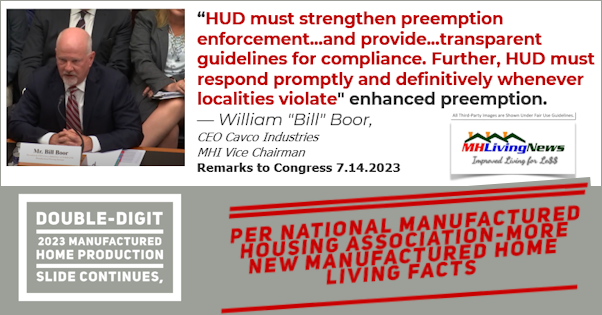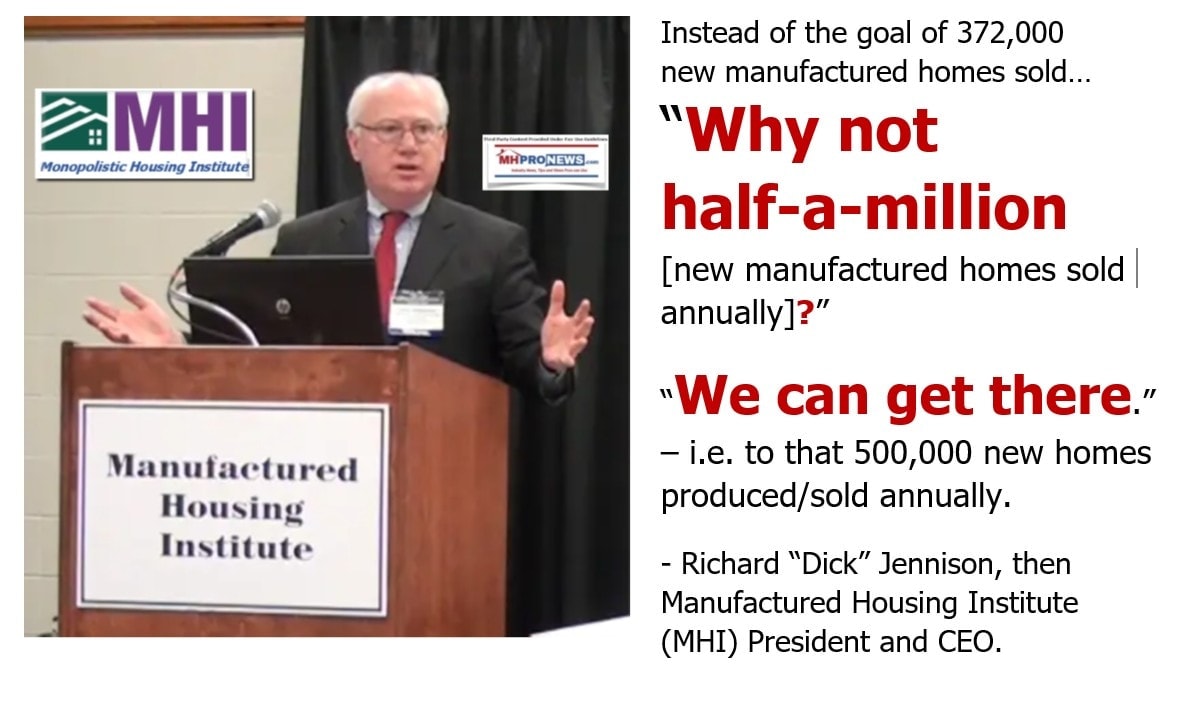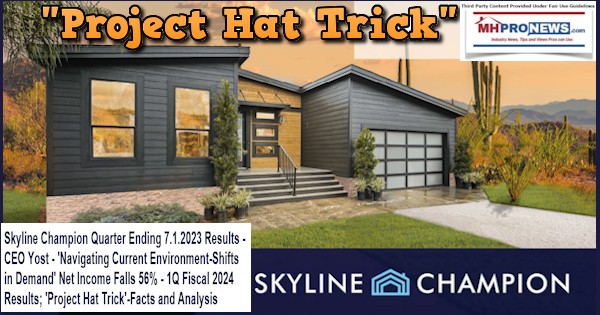
“Operation Breakthrough’s biggest accomplishment, however, was the adoption of the HUD Code, which introduced the industry and the world to manufactured housing.” So says a pull quote from the new report by Regina Gray HUD’s Director of Affordable Housing Research and Technology and its remarks about HUD Code manufactured homes. That article came to MHProNews’ attention some 2 weeks ago, shortly after it was published. As MHProNews periodically does, we decided not to immediately report or comment on Gray’s research and remarks. Why? To see what the Manufactured Housing Institute (MHI) and others in the MHI orbit who are ‘trade media’ or bloggers had to say about Gray’s report.
With that in mind, on 10.2.2023 MHProNews asked Bing’s AI Chat the following question:
> “Has the Manufactured Housing Institute or any manufactured home trade media commented on HUD report Entitled Expanding Housing Choice Through Investments an Innovation and Technology?”
Here is Bing’s response on 10.2.2023.

- Part I of today’s report is Gray’s article as posted on the HUD website.
- Part II is additional information with more MHProNews analysis and commentary.
- Part III is our Daily Business News on MHProNews macro- and manufactured home industry connected firm and updates.
Part I.
Expanding Housing Choice through Investments in Innovation and Technology
Regina C. Gray, Director, Affordable Housing Research and Technology Division, Office of Policy Development & Research
As the Office of Policy Development and Research celebrates its 50th anniversary, the time is right to reflect on our progress in promoting investments in technology that can offer Americans more affordable housing options and transform the homebuilding industry. The drive to build housing more quickly, cheaply, and efficiently is a challenge that HUD has grappled with since its inception. Lessons learned from the Operation Breakthrough demonstration in the late 1960s provide a lens through which we have witnessed considerable progress in industrialized construction. The demonstration was the first attempt to highlight the value of innovation — a new, creative approach to housing construction and building materials — alongside the incorporation of technologies that improve housing performance.
Despite the demonstration’s short-lived success, the program achieved its underlying objective: mass-producing tens of thousands of affordable units. Operation Breakthrough’s biggest accomplishment, however, was the adoption of the HUD Code, which introduced the industry and the world to manufactured housing. The Manufactured Home Construction and Safety Standards Program, which governs the HUD Code, established design, performance, and installation standards for manufactured homes built after June 15, 1976 (“Manufactured Home Construction and Safety Standards,” 2015). In 1994, updated HUD Code energy standards raised minimum insulation requirements and mandated whole house ventilation systems for manufactured homes. Homes built to these standards enhance quality and safety and improve energy performance.
We believe that manufactured housing, once used interchangeably with the term “mobile homes,” is an important segment of the housing stock with the potential to increase the supply of affordable housing for low-income Americans. Since the establishment of the HUD Code, manufactured housing (and offsite construction in general) has undergone many technological, design, and financing changes that have made it indistinguishable in many respects from conventional site-built housing. In fact, in our recent engagements with international delegations, officials have characterized the HUD Code as a precursor to innovation in industrialized construction. Although discussions to modernize the HUD Code are ongoing, nations such as Sweden, the United Kingdom, and Japan look to the code to demonstrate the benefits of industrialized housing construction. As we continue to build our Learning Agenda around innovation and technology, we look to adopt national and international best practices that work.
The Affordable Housing Research and Technology Division (AHRT) provides guidance on technological advancements in housing for HUD through research, data analysis, policy, and demonstrations. Throughout the 1990s and into the new century, AHRT did most of its creative work through the Partnership for Advancing Technology in Housing (PATH). PATH was a public/private initiative that sought to expand the development and use of new technologies to make American homes stronger, safer, and more durable; energy efficient and environmentally friendly; easier to maintain and less costly to operate; and more comfortable places in which to live. PATH linked key agencies in the federal government with leaders from the homebuilding, product manufacturing, insurance, financial, and regulatory communities in a unique partnership focused on technological innovation in the American housing industry. PATH’s mission was to highlight building materials, products, tools and equipment, and systems that are incorporated into housing units and developments to improve performance.
PATH was an ambitious research program that greatly expanded the knowledge base of innovation and technology in housing. Through sponsored research, AHRT researchers learned how building technologies can create a positive impact on housing performance and outcomes. Our research demonstrated that making long-term investments in innovative technologies, such as insulated concrete forms and structural insulated panels, not only improve housing quality but also reduce costs and preserve affordability. AHRT produced more than 100 groundbreaking research products that focused on durable construction materials and installation techniques, improved indoor air quality, investments in technologies that reduce energy consumption in housing, and advancements in offsite construction. Although the PATH program eventually ended, HUD’s mission to show how investments in innovative housing technologies produce high-quality housing continued throughout the following decade and to this day.
The fact that we face challenges to industry uptake of innovative technologies is no secret. The housing industry itself is very diffuse, segmented, and risk averse, with few investments in research and development. PD&R has addressed these challenges head on through its commitment to a robust research and development agenda that helps the housing industry understand its role in advancing innovative technologies. AHRT’s objective is to reduce industry misconceptions and risk aversion to the adoption of new technologies. In a recent publication focused on reducing barriers to innovation in housing, we learned that in efforts to convince housing industry professionals to consider adopting cutting-edge housing technologies, biases and uncertainties persist. Many in the industry believe that adopting new technologies is risky because doing so may increase the cost of materials and skilled labor and slow the construction timetable. These costs, skeptics assert, ultimately get passed on to the consumer in the form of higher housing prices. Improving education on both the supply and demand side of the housing equation, along with presenting a compelling argument backed by empirical evidence for continued investment in research and development, will go a long way toward overcoming this skepticism. Getting persuasive research into industry hands, however, has been challenging — until recently.
With the launch of the Office of Innovation in 2018, PD&R had a vehicle through which AHRT could effectively articulate ways in which the industry could convert research results and technological innovations into feasible actions. The office assisted AHRT in three important aspects: facilitating discussions with industry representatives about our research findings and policy recommendations, promoting the development of the ongoing building technology research grant program, and assisting AHRT with the inaugural Innovative Housing Showcase in 2019.
Through outreach and engaging industry stakeholders, the research community, sister agencies, and affiliated organizations, including the U.S. Department of Energy, the National Institute of Standards and Technology (NIST), and the National Institute of Building Sciences (NIBS), AHRT partnered with experts to develop a robust building technology agenda and research program that has produced more than two dozen studies, guidebooks and toolkits that strengthen the evidence base on how innovative solutions to housing challenges positively impact the preservation of affordable housing. Topics typically focused on the adoption of housing technologies such as high-performing heating, ventilation, and air conditioning systems that improve comfort and indoor air quality; mass timber in industrialized housing; durable housing construction in Indian Country; disaster-proof resilient materials; strategies for reducing carbon emissions in housing; advancements in mass timber and steel construction; and further explorations in market research of offsite construction.
The most recent building technology research grant program asks researchers to help PD&R continue to build on the evidence regarding the potential of offsite construction as an affordable housing solution. Researchers are also tasked with identifying strategies adopted by local governments to reduce restrictive land use zoning requirements that often impede housing construction and reduce the housing supply, which typically cause housing prices to rise. The program resulted from engagement with the National Institute of Building Sciences, which helped PD&R facilitate discussions with the research community, along with MOD X, a research-based consulting firm based in the northeast. The team worked with industry experts, including code officials, to host several events exploring recent domestic and international trends in offsite construction. This engagement not only resulted in several agenda-setting accomplishments, including the Offsite Construction learning agenda, but it also gave PD&R the opportunity to work with the National Association of Home Builders (NAHB), the International Code Council, the National Institute of Building Sciences, and MOD X to host followup panel discussions at the National Building Museum. The meetings would complement the third annual Innovative Housing Showcase, which was held earlier this summer.
This year’s Innovative Housing Showcase involved a joint effort with NAHB to feature innovative housing technologies and construction on the National Mall in Washington, D.C. HUD invited more than a dozen manufacturers and builders to participate alongside representatives from HUD program offices and other federal agencies. Just in time for Homeownership Month, the showcase’s theme was making the pathway to homeownership easier, particularly for those who often face the greatest barriers. As in previous exhibitions, this year’s showcase featured various housing designs and models that employ offsite construction methods, demonstrating many potential housing configurations that consumers can customize according to their needs and preferences. Setting this year’s event apart from previous showcases was the addition of an ADU Alley highlighting accessory dwelling units, which proved to be quite popular with the public, along with exhibits showcasing box homes that can be assembled and installed quickly and then broken down and transported where needed — offering potential uses as shelter for people experiencing homelessness, as a homestay, or as housing for an aging parent.
The Showcase culminated with a house party hosted by HUD Secretary Marcia Fudge to raise awareness about the potential for offsite construction as a promising alternative approach to homeownership. This year’s Innovative Housing Showcase attracted more visitors to the National Mall than did the previous two events, and we felt that we had accomplished what we set out to do: informing interested consumers and skeptics alike about the potential for innovative housing technologies to advance more affordable housing solutions. In the meantime, we continue to build our research capacity and raise awareness of the importance and benefits of technology adoption in housing construction. ## (Published on HUD’s site on 9.19.2023).
Part II – Additional Information with More MHProNews Analysis and Commentary
“Operation Breakthrough’s biggest accomplishment, however, was the adoption of the HUD Code, which introduced the industry and the world to manufactured housing,” said Regina Gray in the article above. Gray added: ” in our recent engagements with international delegations, officials have characterized the HUD Code as a precursor to innovation in industrialized construction. Although discussions to modernize the HUD Code are ongoing, nations such as Sweden, the United Kingdom, and Japan look to the code to demonstrate the benefits of industrialized housing construction. As we continue to build our Learning Agenda around innovation and technology, we look to adopt national and international best practices that work.” Those and other remarks are potentially useful for the manufactured home industry. Which begs the following inquiries.
On 10.2.2023 MHProNews asked Bing’s AI Chat function the following question:
> “Has the Manufactured Housing Institute or any manufactured home trade media commented on HUD PD&R research authored by Pamela Blumenthal and Regina Gray published 9.7.2021?”

Learn more:
- manufacturedhomepronews.com 2. manufacturedhomelivingnews.com 3. manufacturedhomepronews.com 4. einnews.com
So, MHProNews and MHLivingNews – per Bing’s AI chat search function – are the only trade media that have reported on the insightful research by Pamela Blumenthal and Regina Gray. Nor could Bing find any mention by MHI of their useful research report. Recall that MHI’s finally touted their newly updated website (see Part III of the first link below), which MHProNews research suggests has had previously provided information removed from the public side of their website.
Recall that the Washington, D.C. based Manufactured Housing Association for Regulatory Reform (MHARR) pushed forward the statutory evidence-based notion that HUD’s role in manufactured housing IS NOT limited to merely regulatory or data related items. The article below was posted on May 1, 2023. A few months later, Gray posted her item on HUD’s website above. It may be a coincidence. Or it may be a type of ‘response’ to what MHARR argued that HUD should be doing to promote or “facilitate” more manufactured homes.

Either way, missing from Gray’s generally positive insights on manufactured housing is any mention of the fact that for almost a year, manufactured home production has been in decline. Articles related to that are linked below which include comparisons with conventional housing.

According to informed sources, several HUD professionals – as well as others in federal and state government – are regular readers of MHProNews/MHLivingNews. That said, given the opportunity to respond to inquiries by MHProNews, Gray declined comment.
On 9.26.2023 at 4:48 PM, MHProNews sent Gray the following inquiry.
| from: | L. A. Tony Kovach for MHProNews.com | ||
| to: | Regina Gray @hud.gov |
||
| date: | Sep 26, 2023, 4:48 PM | ||
| subject: | Regina, media outreach |
Regina,
We are the largest known and most read trade publication focused on the manufactured housing industry. As you may know, we periodically reference the article you and Pamela Blumenthal co-authored on 9.7.2021. I think it’s important because it makes clear that politicians have been talking about affordable housing for 50 years and yet there is a distinct lack of progress. That said, when your post below was brought to my attention, I read it with keen interest.
https://www.huduser.gov/portal/pdredge/pdr-edge-frm-asst-sec-091923.html
Let me ask a simple question. Why didn’t you mention the Manufactured Housing Improvement Act of 2000 (MHIA) and its so-called “enhanced preemption” provision?
Your reply can be on or off the record. We do longer form articles, so there is no word limit. If your reply is off the record, please indicate that clearly and that is how it will be handled. Thank you.
Tony
L.A. “Tony” Kovach
Managing Member
LifeStyle Factory Homes, LLC
DBAs:
MHLivingNews.com | MHProNews.com | LATonyKovach.com …
Connect on LinkedIn:
http://www.linkedin.com/in/latonykovach
##
Unlike officials at the FHFA or other federal agencies, HUD’s Gray opted not to respond.
MHProNews poised the following search inquiry to Bing’s AI Chat function:
> “Has HUD’s Regina Gray mentioned in any article the Manufactured Housing Improvement Act of 2000 and its enhanced preemption provision?”
Bing’s reply to that was as follows.

























